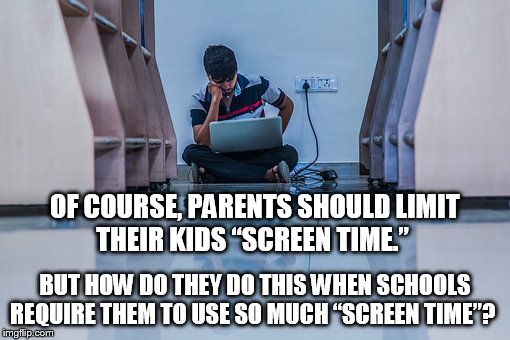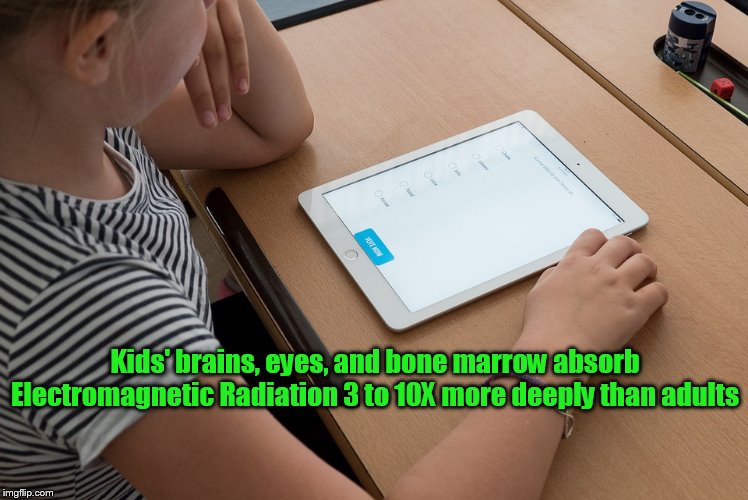 By B.N. Frank
By B.N. Frank
For many years already American tech insiders (aka “Silicon Valley Parents”) have been taking significant measures to limit their own kids use and exposure to screens (see 1, 2, 3, 4). Perhaps that’s because also for many years already, research has revealed that screen use and exposure is harmful to kids of all ages in numerous devastating ways (see 1, 2, 3, 4, 5, 6, 7). Of course – unless precautions are taken – screens expose kids to blue light as well as electromagnetic fields (EMF) and wireless radiation including 5G – all of which are biologically harmful. So all things considered, it can’t really be a big surprise that a new study reveals more bad news about kids’ use of screens.
From StudyFinds.org:
Staring at smartphones for hours can lead to back pain for kids
SÃO PAULO, Brazil — The youth of today are in for a whole lot of back pain if they continue to spend all day staring at screens, a new study warns. After analyzing a group of high schoolers, Brazilian researchers report that excessive screen time has a connection to developing lower back pain — which can then lead to lower grades and even less physical activity.
This new study has identified numerous risk factors among adolescents relating to spinal health and screen time, such as looking at digital devices for more than three hours daily, proximity of the eyes to the screen, and sitting or lying on the stomach.
More specifically, the research team focused on thoracic spine pain (TSP). The thoracic spine is located at the back of the chest, or the thorax, between the shoulder blades, and extends from the bottom of the neck to the start of the lumbar spine. The team gathered their data by surveying 14 to 18-year-old male and female students in either their first or second year of high school in Bauru, a medium-sized city in São Paulo.
In total, 1,628 participants completed the initial, baseline questionnaire between March and June 2017. Among that initial sample, 1,393 returned to complete a follow-up questionnaire in 2018. Researchers’ ensuing analysis showed a one-year prevalence of 38.4 percent (the proportion reporting TSP in both the baseline and follow-up surveys) and a one-year incidence of 10.1 percent (new TSP reported only in the follow-up survey). More girls reported TSP than boys.
TSP is quite common across all age groups worldwide
Its prevalence ranges from 15 to 35 percent in adults and 13 to 35 percent in children and adolescents. Meanwhile, study authors say a major uptick in the use of electronic devices during the COVID-19 pandemic clearly exacerbated the issue. According to numerous earlier studies, risk factors associated with TSP include the physical, physiological, psychological, and behavioral. There’s also plenty of evidence indicating the effects of physical activity, sedentary habits and mental disorders on spinal health. Taken together, all of these factors are seen as critical by the World Health Organization (WHO) in its latest global review of evidence and guidelines.
“The study can be used to inform health education programs for school students, teachers, staff and parents,” says Alberto de Vitta, first author of the article, in a media release.
Dr. Vitta has a PhD in education from the State University of Campinas (UNICAMP) and he completed a postdoctoral fellowship in public health at São Paulo State University (UNESP) in Botucatu.
“This is in line with some of the objectives of the National Curriculum Parameters [PCN, Brazilian government guidelines for secondary schools], according to which schools are responsible for health education, including identification of risks to individual and collective health and interventions to combat them, as well as promotion of self-care habits with regard to the body’s possibilities and limits,” adds Vitta, who is currently teaching and researching at Eduvale College as a faculty member in its Department of Physical Therapy in Avaré, São Paulo state, and the University of Sapucaí Valley’s Graduate Program in Education, Knowledge and Society in Pouso Alegre, Minas Gerais state.
Information on risk factors for TSP in high school students is important, study authors explain, because kids with back pain are more inactive, achieve less academically, and often deal with more psychosocial problems. Additionally, there have been fewer studies on TSP than on lower back and neck pain. A systematic review of the literature on TSP produced only two prospective studies focusing on prognostic factors.
The findings appear in the journal Healthcare.


Be the first to comment on "Screen Use Can Cause Spinal Problems in Kids; Risks Factors Include “physical, physiological, psychological, and behavioral”"